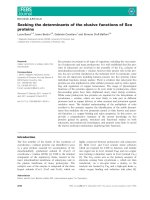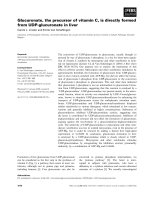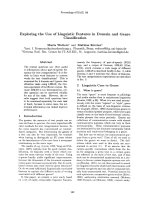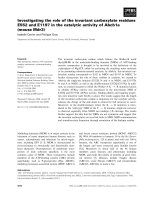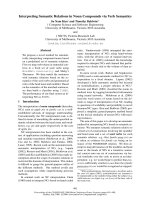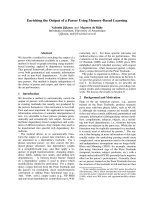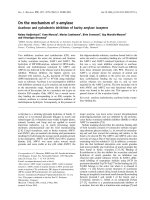Báo cáo khoa học: "Interpreting the variations in xylem sap flux density within the trunk of maritime pine (Pinus pinaster Ait.): application of a model for calculating water flows at tree and stand levels" pdf
Bạn đang xem bản rút gọn của tài liệu. Xem và tải ngay bản đầy đủ của tài liệu tại đây (874.24 KB, 18 trang )
Original
article
Interpreting
the
variations
in
xylem
sap
flux
density
within
the
trunk
of
maritime
pine
(Pinus
pinaster
Ait.):
application
of
a
model
for
calculating
water
flows
at
tree
and
stand
levels
Denis
Loustau
Jean-Christophe
Domec,
Alexandre
Bosc
Laboratoire
d’écophysiologie
et
nutrition,
Inra-Forêts,
BP
45, 33611
Gazinet,
France
(Received
15
January
1997;
accepted
30
June
1997)
Abstract -
Sap
flux
density
was
measured
throughout
a
whole
growing
season
at
different
loca-
tions
within
a
25-year-old
maritime
pine
trunk
using
a
continuous
constant-power
heating
method
with
the
aim
of
1)
assessing
the
variability
of the
sap
flux
density
within
a
horizontal
plane
of the
stem
section
and
2)
interpreting
the
time
shift
in
sap
flow
at
different
heights
over
the
course
of
a
day.
Measurements
were
made
at
five
height
levels,
from
1.3
to
15 m
above
ground
level.
At
two
heights
(i.e.
1.30
m
and
beneath
the
lower
living
whorl,
respectively),
sap
flux
density
was
also
measured
at
four
azimuth
angles.
Additionally,
diurnal
time
courses
of
canopy
transpiration,
needle
transpiration,
needle
and
trunk
water
potential,
and
trunk
volume
variations
were
measured
over
4
days
with
differing
soil
moisture
contents.
At
the
single
tree
level,
the
variability
of
sap
flux
density
with
respect
to azimuth
was
higher
at
the
base
of the
trunk
than
immediately
beneath
the
live
crown.
This
has
important
implications
for
sampling
methodologies.
The
observed
pattern
suggests
that
the
azimuth
variations
observed
may
be
attributed
to
sapwood
heterogeneity
caused
by
anisotropic
distribution
of
the
sapwoods
hydraulic
properties
rather
than
to
a
sectorisation
of
sap
flux.
At
the
stand
level,
we
did
not
find
any
evidence
of
a
relationship
between
the
tree
social
status
and
its
sap
flux
density,
and
this
we
attributed
to
the
high
degree
of homogeneity
within
the
stand
and
its
low
LAI.
An
unbranched
three-compartment
RC-analogue
model
of water
transfer
through
the
tree
is
proposed
as
a
rational
basis
for
interpreting
the
vertical
variations
in
water
flux
along
the
soil-tree-atmosphere
continuum.
Methods
for
determining
the
parameters
of the
model
in
the
field
are
described.
The
model
outputs
are
evaluated
through
a
comparison
with
tree
tran-
spiration
and
needle
water
potential
collected
in
the
field.
(©
Inra/Elsevier,
Paris.)
sap
flux
/
transpiration
/
water
transfer
model
/
Pinus
pinaster
Résumé -
Interprétation
des
variations
de
densité
de
flux
de
sève
dans
le
tronc
d’un
pin
mari-
time
(Pinus pinaster
Ait.):
application
d’un
modèle
de
calcul
des
flux
aux
niveaux
arbre
et
peuplement.
La
densité
de
flux
de
sève
brute
d’un
pin
maritime
de
25
ans
a
été
mesurée
en
*
Correspondence
and
reprints
Fax:
(33)
56 68 05 46;
e-mail:
continu
à
différentes
positions
du
tronc
et
durant
une
saison
de
croissance
complète,
par
une
méthode
à
flux
de
chaleur
constant,
dans
le
but
a)
d’étudier
la
variabilité
de
la
densité
de
flux
dans
la
section
transversale
du
tronc
et
b)
d’analyser
le
décalage
de
temps
du
signal
entre
différentes
hauteurs
au
cours
de
la
journée.
Les
mesures
ont
été
effectuées
à
cinq
hauteurs,
de
1,3
à
15
m
au
dessus
du
sol.
À
deux
niveaux
(1,3
m
et
sous
la
couronne
vivante,
respectivement)
la
densité
de
flux
a
été
mesurée
suivant
quatre
azimuts.
L’évolution
journalière
de
la
transpiration
du
cou-
vert,
de
la
transpiration
des
aiguilles,
du
potentiel
hydrique
du
tronc
et
des
aiguilles
et
des
varia-
tions
de
volume
du
tronc
a
aussi
été
mesurée
durant
quatre
journées
couvrant
une
gamme
de
niveaux
d’humidité
du
sol.
Au
niveau
arbre, la
variabilité
de
la
densité
de
flux
de
sève
dans
la
sec-
tion
horizontale
de
l’aubier
était
plus
élevée
à
la
base
du
tronc
que
sous
la
couronne.
Ceci
pour-
rait
s’expliquer
par
l’anisotropie
des
propriétés
mécaniques
et
hydrauliques
du
bois
dans
le
plan
horizontal,
classique
chez
le
pin
maritime,
plutôt
que
par
une
sectorisation
du
flux
liée
à
l’archi-
tecture
de
la
couronne.
Au
niveau
peuplement,
aucune
relation
entre
la
densité
de
flux
de
sève
et
le
statut
social
de
l’arbre
n’a
été
mise
en
évidence,
ce
qui
s’explique
par
l’homogénéité
du
peu-
plement
et
son
faible
indice
foliaire.
Nous
avons
utilisé
un
modèle
de
transfert
RC
à
trois
com-
partiments
pour
interpréter
les
variations
de
flux
de
sève
le
long
du
transfert
sol-aiguille.
Les
méthodes
de
détermination
des
résistance
et
capacitance
de
chaque
compartiment
sont
décrites.
Les
sorties
du
modèle ont
été
comparées
avec
les
mesures
de
transpiration,
flux
de
sève
et
de
poten-
tiel
hydrique
mesurées
dans
deux
peuplements
âgés
de
25
et
65
ans
respectivement
Le
modèle
explique
assez
bien
les
variations
de
flux
observées
le
long
du
continuum
sol-aiguille.
Au
cours
de
la
sécheresse,
on
observe
une
augmentation
importante
(x
10)
de
la
résistance
du
comparti-
ment
racine-tronc.
Cette
augmentation
est
moins
importante
dans
les
branches
(x
2).
Les
capa-
citances
sont
peu
affectées
par
la
sécheresse.
(©
Inra/Elsevier,
Paris.)
Pinus
pinaster
Ait
/ transpiration
/
flux
de
sève
/
modèle
de
transfert
hydrique
1.
INTRODUCTION
Sap
flow
measurement
is
a
useful
method
for
assessing
the
water
use
by
for-
est
trees;
it
does
not
require
horizontally
homogeneous
stand
structure
and
topog-
raphy
and
therefore
can
be
used
in
situa-
tions
where
methods
such
as
eddy
covari-
ance
cannot.
Sap
flow
measurements
allow
one
to
partition
the
stand
water
flux
between
canopy
sublayers
or
to
discrimi-
nate
between
particular
individuals
in
a
stand.
Sap
flow
data
have
been
used
for
estimating
hourly
transpiration
and
canopy
conductances
in
a
range
of
forest
stands
[1, 10, 13, 19, 20].
The
sap
flow
mea-
surements
can
provide
a
useful
investiga-
tive
tool
for
a
variety
of
purposes,
pro-
viding
the
results
can
be
properly
upscaled
to
the stand
level,
which
requires
a
descrip-
tion
of
the
network
of
resistances
and
capacitances
which
characterise
the
path-
way
of
water
between
the
soil
and
the
atmosphere
[18,
26].
In
order
to
do
this,
we
need
a
scheme
for
quantitatively
inter-
preting
sap
flow
measurements
on
a
ratio-
nal
basis.
Until
now,
the
methods
used
for
extrapolating
sap
flow
data
to
estimate
stand
transpiration
have
remained
rather
empirical,
with
the
capacitances
in
the
water
transfer
process
within
trees
either
being
ignored
[1, 7,
19]
or
extremely
sim-
plified,
such
as
being
reduced
to
a
con-
stant
time
shift
between
sap
flux
and
tran-
spiration
[13].
Resistance
and
capacitance
to
water
transfer
within
some
forest
trees
have been
determined
for
stem
segments
[9, 31]
and
for
whole
trees
(using
cut-tree
experiments).
However,
the
extent
to
which
these
measured
values
can
be
applied
under
natural
conditions
is
ques-
tionable,
since
both
methods
rely
on
the
analysis
of
pressure-flux
relationships
and
water
retention
curves
determined
mainly
under
positive
or
slightly
negative
pres-
sures
[9].
Cohen
et
al.
[4]
proposed
a
method
for
estimating
soil-to-leaf
bulk
resistance
in
the
field
based
on
sap
flux
measurement
which
avoided
this
’arte-
fact’,
and
has
been
applied
to
different
forest
species
[1,
14,
23].
Using
a
resis-
tance-capacitance
analogue
of
the
flow
pathway,
Wronski
et
al.
[37]
and
Milne
[25]
derived
values
of
stem
resistance
and
capacitance
from
field
measurements
of
water
potential,
stem
shrinkage
and
tran-
spiration
on
radiata
pine
and
sitka
spruce,
respectively.
The
aim
of
this
paper
is
to
present
a
simple
RC
analogue
of
water
transfer
within
the
soil-tree-atmosphere
contin-
uum
in
order
to
interpret
diurnal
variations
of
flux
and
water
potential
observed
at
dif-
ferent
locations
in
the
tree.
Methods
are
described
that
allow
the
determination
of
both
the
resistance
and
capacitance
of
the
tree,
based
on
sap
flux
measurement
in
the
field.
In
addition,
we
summarise
the
results
obtained
concerning
the
sap
flux
hetero-
geneity
within
a
maritime
pine
stand
in
a
horizontal
plane
and
suggest
methods
for
improving
the
accuracy
of
the
estimation
of
water
flux
at
tree
and
stand
levels.
2.
AN
UNBRANCHED
RC
MODEL
OF
TREE
WATER
FLUX
The
flow
pathway
along
the
soil-tree-
atmosphere
continuum
is
considered
as
a
series
of RC
units.
This
sort
of
model
was
first
applied
by
Landsberg
et
al.
[22]
on
apple
trees
and
solutions
for
estimating
the
water
potential
from
transpiration
mea-
surements
was
given,
e.g.
by
Powell
and
Thorpe
[28].
The
present
model
consid-
ers
the
tree
as a
three-compartment
sys-
tem:
i)
root
and
trunk,
ii)
branches
and
iii)
needles.
Such
an
approach
has
been
applied
to
different
coniferous
trees,
e.g.
Pinus
radiata
[37],
Picea
sitchensis
[25]
and
Picea
abies
[5].
Figure
I
illustrates
the
electrical
analogue
of
the
model.
The
main
assumptions
of
our
analysis
can
be
summarised
as
follows:
-
the
crown
is
treated
as
a
big
leaf
with
a
homogeneous
temperature
and
transpi-
ration
rate;
-
the
resistance
and
capacitance
of
each
compartment
are
independent
of
the
flux
or
water
potential
of
the
compartment
and
remain
constant
during
the
day
(but
they
can
change
between
days);
-
there
is
no
storage
resistance,
that
is
the
water
potential
gradient
between
the
reservoir
and
the
xylem
can
be
neglected.
In
the
following,
all
the
fluxes,
resis-
tances
and
capacitances
are
expressed
on
an
all-sided
needle
area
basis.
The
water
potential
values
used
in
the
present
paper
are
corrected
for
the
gravitational
gradi-
ent.
The
basic
equations
for
each
com-
partment
are
as
follows:
where
where
Ji
is
the
liquid
water
flux
expressed
in
kg·m
-2·s-1
,
Jr
i
the
storage
flux,
Ri
(MPa·kg
-1·m
2
·s)
and
Ci
(kg·m
-2
·MPa
-1
)
the
resistance
and
capacitance
of
the
com-
partment
and Ψ
i
its
water
potential
(MPa).
The
subscript
i denotes
the
compartment
and
can
be
either
c
for
the
branches
of
the
crown,
s for
the
stem
and
root,
or
n
for
the
needles.
If
we
assume
that
any
change
in
the
water
potential
of
the
lower
compart-
ment
during
each
time
step
can
be
neglected,
replacing
Jr
i
and
Ji
in
equa-
tion
(1)
leads
to
the
differential
equation:
which
can
be
solved
for Ψ
i
and Jr
i,
giving
the
following
expressions:
Equations
(1),
(5)
and
(6)
allow
us
to
estimate
iteratively
the
time
course
of
water
flux
and
potential
from
the
initial
values
of
a
given
flux,
Ji,
and
water
poten-
tial, Ψ
i.
The
parameters
of
the
model
can
be
derived
as
follows.
The
resistance
of
each
compartment
is
given
by
the
slope
of
the
regression
line
relating
the
instantaneous
sap
flux
within
the
compartment,
Ji,
to
the
instantaneous
difference
between
the
water
potentials
at
its
upper
and
lower
bound-
aries,
i.e.
Ψ
i
(t) - Ψ
i-1(t)
[equation
(3)].
A
similar
calculation
has
been
applied
pre-
viously
for the
whole
tree,
e.g.
by
Cohen
et
al.
[4],
Granier
et
al.
[14]
and
Bréda
et
al.
[1].
This
analysis
must
be
carried
out
with
data
covering
the
entire
daily
time
course,
where
the
final
water
content
of
the
tree
is
equal
to
the
initial.
It
does
not
necessarily
require
that
measurements
be
made
under
steady-state
conditions,
i.e.
Jr
i
(t)
may
take
positive
or
negative
val-
ues.
In
order
to
estimate
the
capacitance
of
the
root
+
stem
and
branch
compartments,
we
calculate
the value
of
exp (
-Δt R
i
· C
i)
as
the
slope
of
the
regression
line
fitted
between
Jr
i
(t)
and
according
to
equation
(6)
and
then
extract
the
value
of
Ci
using
the
value
of
Ri
cal-
culated
previously.
For
the
capacitance
of
the
needle
compartment,
we
used
a
value
of
0.025
kg·MPa
-1·m-2
,
assuming
a
bulk
elastic
modulus
of
25
MPa
[36]
and
a
semi-cylindrical
needle
shape
with
an
average
diameter of 0.002
m.
3.
MATERIALS
AND
METHODS
3.1.
Sites
The
model
was
parameterised
and
evalu-
ated
using
data
collected
from
two
different
experiments,
at
the
Bray
site
in
France
(44°42N,
0°46W)
and
the
Carrasqueira
site
in
Portugal
(38°50N,
8°51W)
(table
1).
Both
sites
were
pure
even-aged
stands
of
maritime
pine
with
an
LAI
ranging
between
2.0
and
3.5.
In
both
locations,
the
soil
water
retention
capac-
ity
is
rather
low
due
to
the
coarse
texture
of
the
soil
and
a
summer
rainfall
deficit
that
induces
soil
drought
and
subsequent
tree
water
stress,
this
summer
drought
being
far
more
severe
at
the
Portuguese
site.
The
sites
were
equipped
with
neutron
probe
access
tubes
and
scaffolding
towers,
enabling
monitoring
of
the
soil
moisture
and
micrometeorological
vari-
ables.
The
Bray
site
has
been
extensively
stud-
ied
since
1987
and
a
detailed
description
can
be
found,
e.g.
in
Diawara
et
al.
[6].
The
Car-
rasqueira
site
is
also
part
of
several
Portuguese
and
European
research
projects
and
is
described
by
Loustau
et
al.
[24].
Determination
of
the
model
parameters
was
carried
out
for
a
single
tree
at
the
Bray
site
on
4
days
(days
153,
159,
229
and
243)
in
1995.
Table
II
summarises
the
sampling
procedure
applied
for
each
variable
measured.
3.2.
Azimuthal
variability
of
sap
flux
density
Azimuthal
variations
in
sap
flux
density
across
the
sapwood
horizontal
section
were
assessed
on
three
trees
at
the
Bray
site.
Sen-
sors
were
inserted
at
a
height
of
1.30
m
in
four
azimuthal
orientations.
For
one
tree,
sensors
were
inserted
at
1.50
and
8.50
m,
just
below
the
last
living
whorl.
Sap
flux
densities
were
monitored
from
May
to
August
1991
on
two
trees,
and
from
May
to
September
1995
on
the
tree
with
two
measurement
heights.
The
trees
were
then
cut
and
a
cross
section
of
stems
at
each
measurement
height
was
cut,
rubbed
down,
polished
and
scanned
with
a
high
reso-
lution
scanner
(Hewlett
Packard
Scanjet
II
cx).
The
number
of
rings
crossed
by
each
heating
probe
and
the
total
conducting
area
were
deter-
mined
together
with
the
ratio
between
the
ear-
lywood
and
latewood
area
crossed
by
the
probe.
We
analysed
only
the
data
collected
during
clear
days
and
considered
only
the
nor-
malised
daily
sums
of
sap
flux
density.
In
order
to
analyse
the
between-tree
vari-
ability
of
sap
flux
density,
we
collected
sap
flux
data
from
three
different
experiments,
at
the
Bray
Site
in
1989
and
in
1994
and
at
the
Carrasqueira
site
in
1994.
In
each
experiment,
one
sensor
was
inserted
into
the
northern
face
of
each
stem
and
measurements
were
carried
out
as
described above.
The
data
were
pooled
and
compared
on
a
daily
summation
basis
with
respect
to
the
average
value
of
each
site.
3.3.
Flux
measurement
The
sap
flux
density
of
each
compartment,
ji,
was
measured
using
the
linear
heating
sen-
sor
designed
by
Granier
[ 12]
and
applying
the
empirical
relationship
relating
sap
flux
den-
sity
to
the
thermal
difference
between
the
heated
and
reference
probes.
The
measure-
ments
were
carried
out
on
a
single
tree, referred
to
here
as
the
target tree
(table
III).
No
attempt
was
made
to
take
into
account
possible
natural
gradients
of
temperature
between
the
two
probes
[11
]. At the
Bray
site, the
sap
flux
den-
sity
at
each
measurement level
was
calculated
as
the
arithmetic
mean
of the
values
measured
by
all
the
sensors
at
that
height,
one,
two
or
four
according
to
the
height
(table
II).
At
the
Bray
site, the
whole
tree
water
flux
at
z
=
8.5
m,
Jc,
was
calculated
on
a
leaf
area
basis
by:
where
Ac
is
the
cross-sectional
area
of
the
con-
ductive
pathway
and
L
the
leaf
area
(all
sided)
of
the
tree.
Ac
was
measured
after
the
experi-
ment
on
the
slice
of
wood
extracted
from
the
trunk
at
a
height
of
8.5
m
as
described
above.
L
was
estimated
using
the
sapwood
area-leaf
area
relationship
determined
by
Loustau
(unpublished
data)
from
a
destructive
sampling
of
20
trees
at
the
same
site.
At
Carrasqueira,
only
one
sensor
was
inserted
at
each
level.
In
this
case,
the
stem
sap
flux
at
a
height
of
1.5
m,
Js,
and
beneath
the
crown,
Jn,
was
estimated
by
assuming
that
the
daily
total
of
water
flow
through
the
tree
was
conserved.
This
implies
that
the
daily
total
of
water
flow
at
any
location
within
the
system
is
conserved
and
that
the
ratio
between
the
respective
values
of the
sap-
wood
cross-sectional
area
and
the
daily
sum
of
sap
flux
density
at
any
pair
of
points
of
heights
within
the
tree
is
constant.
Thus,
we
estimated
the
sapwood
cross-sectional
area
of
each
compartment
i (i
≠
c),
Ai,
using
the
ratio
between
its
daily
sap
flux
density,
Σj
i,
and
the
sap
flux
density
beneath
the
crown,
Σj
c,
as
follows:
3.4.
Storage
flux
The
total
storage
flux
of
the
crown
and
stem,
J
ri
,
were
calculated
as
the
instantaneous
difference
between
sap
flux
values
measured
above
and
beneath
the
compartment
consid-
ered,
according
to
equation
(1),
following
Lous-
tau
et
al.
[24].
For
the
stem
storage
only,
the
elastic
storage
flux
into
the
trunk
was
also
esti-
mated
from
trunk
volume
variations,
assum-
ing
these
variations
were
due
only
to
the
trans-
fer
of
water
from
the
phloem
into
the
xylem.
The
dendrometers
used
were
linear
displace-
ment
transducers
(’Colvern’)
regularly
spaced
along
the
stem
(table
II)
and
corrected
for
tem-
perature
variations.
Each
transducer
was
fixed
to
a
PVC
anchor
which
was
attached
to
the
opposite
side
of
the
trunk
using
5-cm-long
screws.
Dead
bark
tissue
was
removed
such
that
the
sensor
was
directly
in
contact
with
external
xylem.
3.5.
Water
potential
measurements
Needle
water
potential
was
measured
hourly
using
a
pressure
chamber.
The
branches
and
trunk
water
potential
were
estimated
using
non-
transpiring
needles
attached
at
the
appropriate
locations
(table
II).
These
needles
were
enclosed
in
waterproof
aluminium-coated
plas-
tic
bags
after
wetting
the
previous
night,
and
it
was
assumed
that
their
water
potential
came
into
thorough
equilibrium
with
the
branch
or
trunk
xylem
to
which
they
were
attached.
The
soil
water
potential
was
estimated
as
the
aver-
age
value
of
15
soil
psychrometric
chambers
used
in
dew-point
mode
(Wescor
soil
psy-
chrometer)
and
buried
at
five
depths
from-10
to
-50
cm.
3.6.
Vapour
flux
measurements
The
transpiration
of
pine
canopy
was
esti-
mated
using
eddy
covariance
measurements
of
the
vapour
flux
at
two
levels,
above
the
tree
crowns
and
in
the
trunkspace
between
the
tree
crown
and
the
understorey.
Fluctuations
in
wind
speed,
temperature
and
in
water
vapour
concentration
were
measured
with
a
3D
or
1D
sonic
anemometer
and
a
Krypton
hygrometer,
respectively.
The
difference
between
the
vapour
fluxes
measured
above
and
beneath
the
pine
crowns
was
assumed
to
give
the
transpi-
ration
of
the
pine
trees
only.
These
measure-
ments
were
available
for
14
days
at
the
Car-
rasqueira
site
in
1994,
and
for
10
days
at
the
Bray
site
in
1995.
The
methods
used,
the
cor-
rections
applied
in
order
to
take
into
account
the
density
effects
and
the
absorption
of
UV
by
oxygen,
energy
balance
closure
tests
and
sam-
pling
procedures
are
detailed
by
Berbigier
et
al.
[2]
for
the
Carrasqueira
site
and
Lamaud
et
al.
[21]
for
the
Bray
site.
4. RESULTS
4.1.
Azimuthal
variability
of
sap
flux
density
in
pine
stands
Figure
2
shows
the
time
course
of
the
measured
sap
flux
density
at
four
azimuth
angles
and
two
heights
in
the
trunk
of
the
target
tree
at
the
Bray
site
throughout
a
typical
spring
day.
There
was
very
little,
if
any,
variation
in
sap
flux
density
with
azimuth
angle
immediately
beneath
the
crown,
whilst
considerable
differences
were
found
at
the
base
of
the
trunk.
This
pattern
was
conserved
throughout
the
whole
measurement
period,
and
was
not
affected
by
soil
drought
(data
not
shown).
Figure
3 summarises
the
results
obtained
concerning
the
variability
of
sap
flux
den-
sity
at
a
height
of
1.30
m
for
three
trees
at
the
Bray
site.
The
relationship
between
sap
flux
density
and
either
the
number
of
rings
or
the
proportion
of
earlywood
crossed
by
the
probe
was
not
significant,
though
there
was
a
trend
for
the
sap
flow
density
to
decrease
as
the
number
of
tree
rings
measured
increased
in
two
out
of
four
trees.
Furthermore,
there
was
no
sig-
nificant
relationship
between
the
varia-
tion
in
sap
flux
density
and
the
stem
basal
inclination,
even
where
the
excentricity
of
heartwood
and
subsequent
sapwood
azimuthal
anisotropy
was
obvious.
No
sig-
nificant
relationship
was
found
between
the
sap
flux
density
measured
at
1.3
m
high
and
tree
size
in
either
experiment
(figure
4).
4.2.
Determination
of
the
parameters
of
the
model
Figure
5
shows
the
flux-water
potential
gradient
relationship
used
in
calculating
the
resistance
of
the
three
compartments
for
2
days
of
contrasting
soil
moisture.
The
corresponding
values
of
the
resis-
tances
are
given
in
table
IV.
Soil
moisture
reached
its
lowest
value
on
days
229
and
243
and
the
predawn
water
potential
mea-
sured
for
these
2
days
(table
IV)
are
typi-
cal
of
those
found
during
a
severe
drought
in
this
area.
There
was
a
dramatic,
8-fold
increase
in
the
resistance
of
the
root-trunk
compartment
under
these
drought
condi-
tions,
which
contrasted
with
a
very
slight
increase
in
the
resistance
of
the
branch
and
needle
compartments.
Figure
6
illustrates
the
procedure
used
for
estimating
the
branch
and
stem
capac-
itance
for
day
153.
We
did
not
observe
any
clear
change
in
the
stem
or
branch
capacitance
for
the
four
sample
days
at
the
Bray
site.
4.3.
Model
evaluation
Figure
7
compares
the
water
potential
values
predicted
by
the
model
and
the
measured
values,
for
day
153
at
the
Bray
site.
There
is
an
acceptable
agreement
between
the
measured
and
predicted
data,
even
if
a
difference
is
observed
during
the
morning
and
late
afternoon
for
the
lower
compartments.
This
figure
also
compares
the
storage
flux
for
the
stem
predicted
by
model
with
the
flux
calculated
from
change
in
the
stem
volume.
This
compar-
ison
shows
that
predicted
and
observed
data
are
the
same
order
of
magnitude
but
differences
remain
at
certain
times
of
the
day.
Figures
8
and
9
show
the
model’s
outputs
together
with
measured
data
for
two
representative
days
at
the
Carrasqueira
and
Bray
sites,
respectively.
The
parame-
ter
values
used
for
implementing
the
model
have been
derived
from
measure-
ments
made
at
different
heights
[24]
and
are
shown
in
table
IV.
The
figures
com-
pare
the
values
of
vapour
flux
predicted
from
sap
flow
measurements
at
the
base
of
the
crown
and
at
the
base
of
the
trunk
with
the
evapotranspiration
data
measured
by
eddy
covariance
for
2
days
on
each
site.
We
’upscaled’
the
sap
flux
values
from
tree
to
stand
using
optically
determined
leaf area
index
values
(table
I),
assuming
the
needles
had
a
semi-cylindrical
shape,
and
calculating
the
sap
flux
as
the
aver-
age
of
the
measurements
made
at
a
height
of
6
m
on
a
sample
of
ten
trees
at
Car-
rasqueira
and
at
a
height
of
8.5
m
on
seven
trees
at
the
Bray
site.
The
time
course
of
the
predicted
values
of
water
potential
are
also
shown
and
compared
with
measured
data
for
the
days
178
and
180
at
the
Car-
rasqueira
site.
The
values
measured
by
eddy
covariance
exhibited
erratic
varia-
tions,
particularly
when
the
weather
regime
was
irregular,
but
the
overall
pat-
tem
showed
acceptable
agreement.
Water
potential
values
predicted
by
the
model
are
also
compared
with
measured
data
for
1
d
(DOY
180
Carrasqueira
site)
and
indi-
cate
that
the
model
predicts
the
measured
values
reasonably
well.
Figure
10
shows
the
relationship
between
the
predicted
and
measured
vapour
flux
values
for
both
sites.
Agreement
is
slightly
better
for
the
Car-
rasqueira
where
data
were
obtained
on
bright
clear
days
than
for
the
Bray
where
data
were
collected
under
changeable
weather
conditions.
DISCUSSION
An
important
methodological
outcome
of
this
work
is
that
a
lower
sampling
error
for
mean
sap
flux
density
of
a
homoge-
neous
stand
should be
expected
when
the
sap
flux
measurements
are
made
imme-
diately
below
the
crown
rather
than
at
ground
level.
This
is
particularly
true
for
trees
exhibiting
basal
trunk
curvature
and
subsequent
wood
excentricity
and
sap-
wood
anisotropy.
We
did
not
find
any
lit-
erature
concerning
the
pattern
of
azimuthal
distribution
of
sap
flux
density
according
to
the
measurement
height
which
could
further
support
this
conclusion.
Since
it is
based
on
measurements
made
on
only
three
trees,
this
conclusion
deserves
addi-
tional
experimental
support.
Sap
flux
den-
sity
variations
could
not
be
related
signif-
icantly
to
the
number
of
rings
or
the
earlywood/latewood
ratio
of
the
sapwood
crossed
by
the
heating
probe.
We
think,
however,
that
such
a
relationship
could
occur
within
a
tree
but
was
not
observed
because
of
the
low
number
of
replicates.
It
may,
nevertheless,
play
an
important
role
since
Dye
et
al.
[8]
showed
that
growth
rings
and
compression
wood
created
a
radial
heterogeneity
in
sap
flux
density
within
the
sapwood
of
another
pine
species,
P.
patula,
and
that
there
was
a
subsequent
heterogeneity
in
the
azimuthal
distribution
of
sap
flux
density.
Addition-
ally,
it
has
long
been
established
that
the
sap
flux
density
varies
radially
within
the
sapwood
cross-sectional
area
[3,
15,
16,
27]
which
could
also
affect
the
azimuthal
distribution
of
sap
flux
in
anisotropic
stems.
The
between-tree
variation
of
sap
flux
density
was,
therefore,
unsurprising
since
the
data
presented
in figure
4 actually
include
the
within-tree
variability.
In
addi-
only
a
weak
between-tree
variation
in
sap
flux
density
would
be
expected
in
these
homogeneous
pine
stands
where
the
leaf
area
index
did
not
exceed
a
value
of
3.
This
precludes
any
major
differences
between
trees
of
differing
social
position.
Models
based
on
a
similar
electrical
analogue,
with
various
degrees
of
sophis-
tication
in
tree
architecture
representation
were
published
by
Powell
and
Thorpe
[28],
Landsberg
[22],
Wronski
et
al.
[37],
Milne
[25]
and
Cruiziat
et
al.
[5]
following
the
pioneer
work
of
Van
den
Honert
[34],
but
their
practical
utilisation
remains
lim-
ited
owing
to
the
large
numbers
of
param-
eters
required.
The
merit
of
the
present
model
is
its
simplicity,
which
could
make
it
useful
for
routine
transpiration
calcula-
tions
from
sap
flow
measurements,
pro-
vided
that
a
proper
parameterisation
of
the
resistance
and
capacitance
values
is
achieved.
This
would
facilitate
using
sap
flow
measurements
to
estimate
tree
tran-
spiration
(and
consequently
surface
con-
ductance)
when
other
techniques
are
impractical,
and
would
allow
partitioning
of
the
vapour
fluxes
among
canopy
lay-
ers
on
a
short
term
basis.
From
this
point
of
view,
the
inadequacy
of
assuming
that
sap
flow
lags
with
a
constant
time
shift
behind
transpiration
should
be
highlighted.
The
constant
time-lag
hypothesis
implies
that
the
water
storage
flux
in
the
tree
would
always
correspond
to
a
constant
time
fraction
of
the
transpiration,
which
is
obviously
erroneous.
The
storage
flux
varies
during
the
day
and
reaches
its
max-
imal
absolute
values
in
the
morning
and
during
the
evening,
and
its
minimal
values,
close
to
zero,
at
midday.
We
observed
a
dramatic
increase
in
the
soil-trunk
resistance
under
low
soil
mois-
ture
conditions,
while
the
needle
and
crown
resistances
were
nearly
unaffected.
This
change
in
resistance
observed
dur-
ing
drought
dramatically
increased
the
time
constant
of
the
soil-trunk
compart-
ment,
which
was
approximately
23
min
with
wet
soil
and
reached
348
min
with
dry
soil.
Consequently,
the
estimation
of
hourly
transpiration
values
from
extrapo-
lating
sap
flow
measurements
made
at
the
base
of
the
trunk
becomes
extremely
dif-
ficult
on
dry
soil
since
a
very
accurate
measurement
of
the
water
potential
at
the
soil-root
interface
becomes
necessary.
The
major
cause
of
this
increase
in
the
root-trunk
compartment
may
be
attributed
to
the
decrease
in
soil
hydraulic
conduc-
tivity
in
the
vicinity
of
the
roots,
since
the
trunk
and
root
xylem
of
coniferous
trees
have
not
been
reported
as
showing
a
sub-
stantial
reduction
in
hydraulic
conductiv-
ity
caused
by
cavitation
of
tracheids
at
these
levels
of
water
potential
[32].
Another
important
consequence
of
this
increase
in
time
constant
under
soil
drought
is
that,
under
extremely
dry
con-
ditions,
trees
might
not
have
sufficient
time
overnight
to
restore
their
equilibrium
water
content.
During
a
continuous
period
of
drought,
we
can
therefore
hypothesise
that
trees
having
a
large
time
constant,
such
as
large
coniferous
trees,
could
expe-
rience
a
sort
of
’runaway’
dehydration
resulting
in
them
drying
faster
than
the
soil
itself.
An
interesting
practical
issue
arising
from
the
present
paper
is
our
method
for
estimating
the
values
of
the
bulk
resis-
tance
and
capacitance
of
each
compart-
ment
under
natural
conditions
with
mini-
mum
disturbance
to
the
tree.
These
methods
are
consistent
with
the
use
of
the
parameter
values
in
the
model.
Estima-
tion
of
the
bulk
resistance
of
a
transfer
compartment
through
analysis
of
the
flux-water
potential
relationship
has
been
widely
used
by
several
authors,
but
has
seldom
been
applied
to
subparts
of
trees
in
the
field.
Present
methods
rely
on
accu-
rate
determinations
of
the
tree
sap
flow,
which
requires
determination
of
sapwood
area,
mean
sapflux
density
and
needle
area
in
a
stand
to
a
high
degree
of
accuracy.
Thus,
application
of
this
principle
could
therefore
be
questionable
in
the
case
of
a
heterogeneous
stand.
Despite
large
scat-
ter
in
the
data,
mainly
caused
by
the
rapid
changes
in
evaporative
demand
during
the
measurement
days,
the
estimated
values
of
capacitance
(0.078
and
0.038
kg
·m-2
·MPa
-1
)
are
within
the
expected
range
of
magnitude
for
coniferous
trees
[30].
The
capacitances
found
for
the
stem
and
branches
are
within
the
range
of
the
values
estimated
from
the
measurements
made
by
Edwards
et
al.
[9]
on
two
other
conif-
erous
species,
Pinus
contorta
and
Picea
sitchensis.
These
capacitances
were
not
affected
during
drought,
a
logical
conse-
quence
of
the
conservation
of
water
poten-
tial
of
each
compartment
resulting
from
stomatal
closure
and
a
subsequent
drop
in
water
flux.
We
recognise
that
the
parameterisation
of
the
model
relies
on
a
small
number
of
replicates
at
both
sites.
It
would
be
nec-
essary
to
enlarge
the
sample
size
of
the
measurements
of
flux
and
water
potential
to
achieve
more
confidence
in
upscaling
the
model
from
the
tree
to
the
stand
level.
Despite
this
restriction,
our
approach
allows
us
to
investigate
changes
in
water
flux
along
the
soil-tree-atmosphere
con-
tinuum
and
has
provided
a
method
for
pre-
dicting
the
water
potentials
and
water
fluxes
at
any
point
of
the
system
which
we
have
shown
to
be
roughly
consistent
with
data
obtained
from
two
different
sites.
Among
the
assumptions
made
a
priori
in
the
model,
two
of
them
may
restrict
its
use
and
deserve
therefore,
some
critical
analysis.
1)
The
capacitances
of
the
tree
com-
partments
were
assumed
to
be
constant
over
the
range
of
water
potential
experi-
enced.
This
assumption
seems
reasonable
from
the
established
relationship
between
needle
water
potential
and
water
content
but
very
little
is
known
about
the
water
relations
of
elastic
tissues
such
as
the
stem
phloem,
which
appears
from
figure
7
to
be
the
major
component
of
the
trunk
and
branch
capacitances.
In the
longer
term,
the
xylem
of
most
coniferous
trees
is
known
to
play
a role
as
a
water
reservoir
[35]
but
it
appears
to
play
an
insignificant
role
on
a
daily
basis
[17, 37].
2)
The
tree
is
divided
into
homoge-
neous
compartments
characterised
by
a
set
of
unique
values
of
water
potential,
storage
flux
and
main
flux.
This
approxi-
mation
is
acceptable
when
the
model
includes
a
large
number
of
small-size
com-
partments
and
runs
on
a
short-time
reso-
lution,
typically
seconds,
which
is
not
the
case
here.
Nevertheless,
we
feel
this
assumption
is
still
acceptable
for
the
nee-
dle
and
branch
compartments
for
which
spatial
variations
in
water
potential
val-
ues
do
not
exceed
0.15
MPa
(Loustau,
unpublished
results).
This
simplification
is
questionable
for
the
lower
compartment,
which
includes
both
the
stem
and
root
sys-
tems
and
may
exhibit
spatial
differences
in
water
potential
as
large
as
0.5
MPa.
Ignor-
ing
the
resistance
between
storage
tissues
and
xylem
may
also
lead
to
underestimates
of
the
time
constant
of
the
trunk
and
branch
compartments,
even
if
Milne
(1989)
found
its
value
negligible
when
compared
to
the
resistance
of
the
main
pathway.
ACKNOWLEDGEMENTS
The
data
of
vapour
fluxes
determined
by
the
eddy
covariance
method,
and
leaf
area
index
values
derived
from
optical
measure-
ments
were
measured
by
Paul
Berbigier,
Yves
Brunet
and
Eric
Lamaud
during
the
French
project
AgriGES
at
the
Bray
site
and
the
Por-
tuguese
STRIDE
project
(STRDA/C/AGR/
159/92)
at
the
Carrasqueira
site.
The
authors
gratefully
acknowledge
them
for
providing
these
data.
We
thank
I.
Ferreira-Gama
and
J.S.
Pereira,
coordinators
of
the
STRIDE
project,
for
giving
us
the
opportunity
to
participate
in
this
project.
The
work
described
in
this
paper
was
supported
by
the
EU
projects
LTEEF
(EV5V-CT94-0468)
and
EUROFLUX.
Dur-
ing
his
D.E.A.
work,
J.C.
Domec
was
sup-
ported
by
a
fellowship
of
the
Ministère
de
l’Agriculture.
The
Carrasqueira
and
Bray
sites
were
used
by
courtesy
of
the
Companhia
das
Lezirias
and
the
Compagnie
France-Forêts,
respectively.
M.
Rayment
provided
an
invalu-
able
help
for
language
and
style
improvement.
REFERENCES
[1]
Bréda
N.,
Cochard
H.,
Dreyer
E.,
Granier
A.,
Water
transfer
in
a
mature
oak
stand
(Quercus
petraea):
seasonal
evolution
and
effects
of
a
severe
drought,
Can.
J.
For.
Res.
23
(1993)
1136-1143.
[2]
Berbigier
P.,
Bonnefond
J.M.,
Loustau
D.,
Ferreira
M.I.,
David
J.S.,
Pereira
J.S.,
Tran-
spiration
of
a
64-year-old
maritime
pine
stand
in
Portugal:
11
evapotranspiration
and
stomatal
conductance
measured
by
an
eddy
covari-
ance
technique,
Oecologia
107
(1996)
43-52.
[3]
Cermak
J.,
Cienciala
E.,
Kucera
J.,
Hällgren
J
E.,
Radial
velocity
profiles
of
water
flow
in
trunks
of norway
spruce
and
oak
and
the
response
of
spruce
severing,
Tree
Physiol.,
10 (1992) 367-380.
[4]
Cohen
Y.,
Fuchs
M.,
Cohen
S.,
Resistance
to
water
uptake
in
a
mature
citrus
tree,
J.
Exp.
Botany
34
(1983) 451-460.
[5]
Cruiziat
P.,
Granier
A.,
Claustres
J.P.,
Lachaize
D.,
Diurnal
evolution
of
water
flow
and
potential
in
an
individual
spruce:
exper-
imental
and
theoretical
study,
Ann.
Sci.
For.
46
suppl. (1989)
353-356.
[6]
Diawara
A.,
Loustau
D.,
Berbigier
P.,
Com-
parison
of
two
methods
for
estimating
the
evaporation
of
a
Pinus
pinaster
stand:
sap
flow
and
energy
balance
with
sensible
heat
flux
measurements
by
an
eddy
covariance
method,
Agric.
For.
Meteorol.
54
(1991)
49-66.
[7]
Dye
P.J.,
Olbrich
B.W.,
Estimating
transpi-
ration
from
6-year-old
Eucalyptus
grandis
trees:
development
of
a
canopy
conductance
model
and
comparison
with
independent
sap
flux
measurements.
Plant
Cell
Environ.
16
(1993) 45-53.
[8]
Dye
P.J.,
Olbrich
D.B.,
Poulter
A.G.,
The
influence
of
growth
rings
in
pinus
patula
on
heat
pulse
velocity
and
sap
flow
measure-
ment,
J.
Exp.
Botany
42
(1991)
867-870.
[9]
Edwards
W.R.N.,
Jarvis
P.G.,
Relations
between
water
content,
potential
and
perme-
ability
in
stems
of
conifers,
Plant
Cell
Envi-
ron.
5
(1982)
271-277.
[10]
Filho
T.,
Damesin
C.
Rambal
S.,
Joffre
R.,
Retrieving
leaf
conductances
from
sap
flows
in
a
mixed
mediterranean
woodland:
a
scaling
exercise,
Ann.
Sci.
For.
55
(1998)
173-190.
[11]
Goulden
M.L.,
Field
C.B.,
Three
methods
for
monitoring
the
gas
exchange
of
individual
tree
canopies:
ventilated-chamber,
sap-flow
and
Penman-Monteith
measurements
on
ever-
green
oaks,
Functional
Ecol.
8
(1994)
125-135.
[12]
Granier
A.,
Mesure
de
flux
de
sève
brute
dans
le
tronc
du
Douglas
par
une
nouvelle
méthode
thermique,
Ann.
Sci.
Forest.
44
(1)
(1987).
[13]
Granier
A.,
Loustau
D.,
Measuring
and
mod-
elling
the
transpiration
of
a
maritime
pine
canopy
from
sap-flow
data,
Agric.
For.
Mete-
orol. 22 (1994)
145-158.
[14]
Granier
A.,
Bréda
N.,
Claustres
J.P.,
Colin
F.,
Variation
in
hydraulic
conductance
of
some
adult
conifers
under
natural
conditions,
Ann.
Sci.
For.
46
suppl. (1989)
357-360.
[15]
Granier
A.,
Anfodillo
T.,
Sabatti
M.,
Cochard
H.,
Dreyer
E.,
Tomasi
M.,
Valentini
R,
Bréda
N
Axial
and
radial
water
flow
in
the
trunks
of
oaks
trees:
a
quantitative
and
qualitative
analysis,
Tree
Physiol.
14 (1994)
1383-1396.
[ 16]
Hatton
T.J.,
Catchpole
E.A.,
Vertessy
R.A.,
Integration
of
sapflow
velocity
to
estimate
plant
water
use,
Tree
Physiol.
6
(1990)
201-209.
[17]
Herzog
K.M.,
Hasler
R.,
Thum
R.,
Diurnal
changes
in
the
radius
of
a
subalpine
norway
spruce
stem: their
relation
to
the
sap
flow
and
their
use
to
estimate
transpiration,
Trees
10
(1995) 94-101.
[18]
Hunt
R.E.,
Running
S.R.,
Federer
C.A.,
Extrapolating
plant
water
flow
resistances
and
capacitances
to
regional
scales,
Agric.
For.
Meteorol.
54
(1991)
169-195.
[19]
Köstner
B.M.M.,
Schulze
E.D.,
Kelliher
F.M.,
Hollinger
D.Y.,
Byers
J.N.,
Hunt
J.E.,
McSev-
eny
T.M.,
Meserth
R.,
Weir
P.L.,
Transpira-
tion
and
canopy
conductance
in
a
pristine
broad-leaved
forest
of Nothofagus.
An
anal-
ysis
of
xylem
sap
flow
measurement,
Oecolo-
gia 91
(1992)
350-359.
[20]
Köstner
B.,
Alsheimer
M.,
Falge
E.,
Geyer
R.,
Tenhunen
J.,
Relationships
between
canopy
transpiration,
conductance,
and
tree
capacitance
of
an
old
Norway
spruce
(picea
abies)
stand.
Ann.
Sci.
For.
55
(1998)
125-139.
[21]
Lamaud
E.,
Brunet
Y.,
Berbigier
P.,
Radiation
and
water
use
efficiencies
of two
coniferous
forest
canopies,
Proceedings
of the
EGS
XXI
General
Assembly,
6-10
May
1996,
The
Hague,
EGS,
1998.
[22]
Landsberg
J.J.,
Blanchard
T.W.,
Warrit
B.,
Studies
on
the
movement
of
water
through
apple
trees.
J.
Exp.
Botany,
27
(1976)
579-596.
[23]
Loustau
D.,
Granier
A.,
El
Hadj
Moussa
F.,
Evolution
saisonnière
du
flux
de
sève
dans
un
peuplement
de
Pin
maritime.
Ann.
Sci.
For.
21
(1990) 599-618.
[24]
Loustau
D.,
Berbigier
P.,
Roumagnac
P.,
Arruda
Pacheco
C.,
David
J.S.,
Ferreira
M.I.,
Pereira
J.S.,
Tavares
R.,
Transpiration
of
a
64-year-old
Maritime
Pine
in
Portugal:
1.
Seasonal
course
of
water
flux
through
mar-
itime
pine,
Oecologia
107
(1996)
33-42.
[25]
Milne
R.,
Diurnal
water
storage
in
the
stems
of Picea
sitchensis
(Bong.)
Carr,
Plant
Cell
Environ.
12 (1989) 63-72.
[26]
Philips
N.,
Oren
R.,
A
comparison
of
daily
representations
of
canopy
conductance
based
on
two
conditional
time-averaging
methods,
Ann.
Sci.
For.
(1998).
[27]
Phillips
N.,
Oren
R.,
Zimmermann
R.,
Radial
patterns
of
xylem
sap
flow
in
non-,
diffuse-
and
ring-
porous
tree
species,
Plant
Cell
Env-
iron.
19 (1996) 983-990.
[28]
Powell
D.B.B.,
Thorpe
M.R.,
Dynamic
aspects
of
plant-water
relations,
in:
Lands-
berg
J.J.,
Cutting
C.V.
(Eds.),
Environmental
Effects
on
Crop
Physiology,
London-Aca-
demic
press,
1977,
pp.
259-79.
[29]
Schultze
E.D.,
Cermak
J.,
Matyssek
R.,
Penka
M.,
Zimmermann
R.,
Vasicek
F.,
Gries
W.,
Kucera
J.,
Canopy
transpiration
and
water
fluxes
in
the
xylem
of the
trunk
of
Larix
and
Picea
trees -
a
comparison
of
xylem
flow,
porometer
and
cuvette
measurements.
Oecologia
66
(1985)
475-783
[30]
Tyree
M.T.,
A
dynamic
model
for
water
flow
in
a
single
tree:
evidence
that
models
must
account
for
hydraulic
architecture,
Tree
Phys-
iol. 4 (1988)
1985-217.
[31]
Tyree
M.T.,
Sperry
J.S.,
Vulnerability
of
xylem
to
cavitation
and
embolism.
Ann.
Rev.
Plant
Physiol.
Mol.
Biol.
40
(1989)
19-38.
[32]
Van
Den
Honert
T.H.,
Water
transport
in
plants
as
a
catenary
process,
Discuss.
Faraday
Soc. 3 (1948)
146-153.
[33]
Waring
R.H.,
Running
S.W.,
Sapwood
water
storage:
its
contribution
to
transpiration
and
effect
upon
water
conductance
through
the
stems
of
old-growth
Douglas
fir,
Plant
Cell
Environ.
1 (1978)
131-140.
[34]
Whitehead
D.,
Jarvis
P.G.,
Coniferous
for-
est
and
plantations,
in:
Kozlowski
T.T.
(Ed.),
Water
Deficits
and
Plant
Growth,
Vol.
VI,
Academic
Press
NY-London-Toronto-Syd-
ney-San
Francisco,
1981,
pp.
50-132.
[35]
Wronski
E.B.,
Holmes
J.W.,
Turner
N.C.,
Phase
and
amplitude
relations
between
tran-
spiration,
water
potential
and
stem
shrink-
age.
Plant
Cell
Environ.
8
(1985)
613-622.
